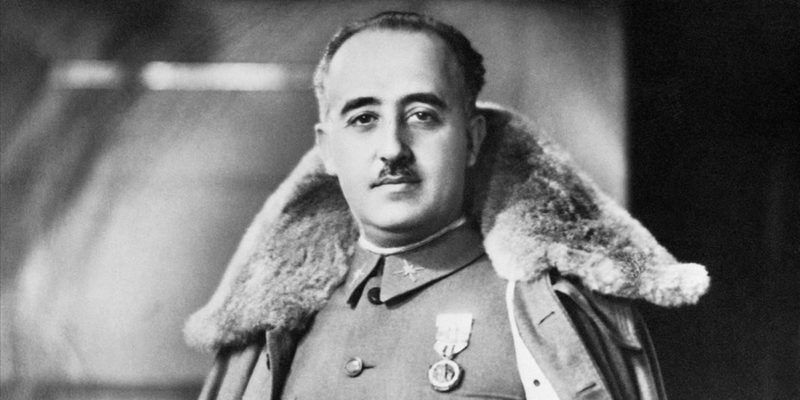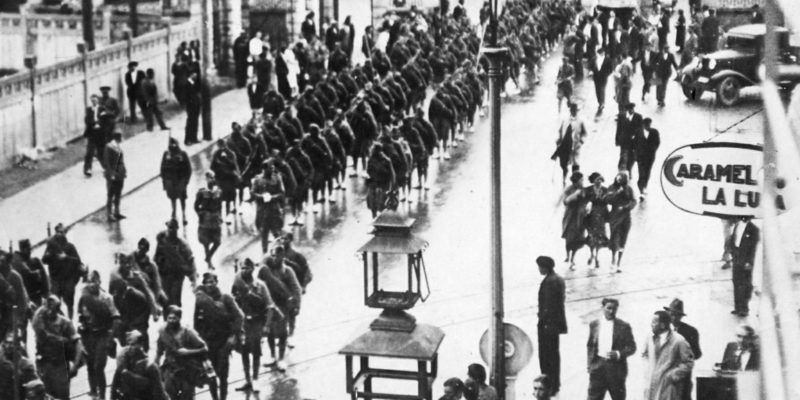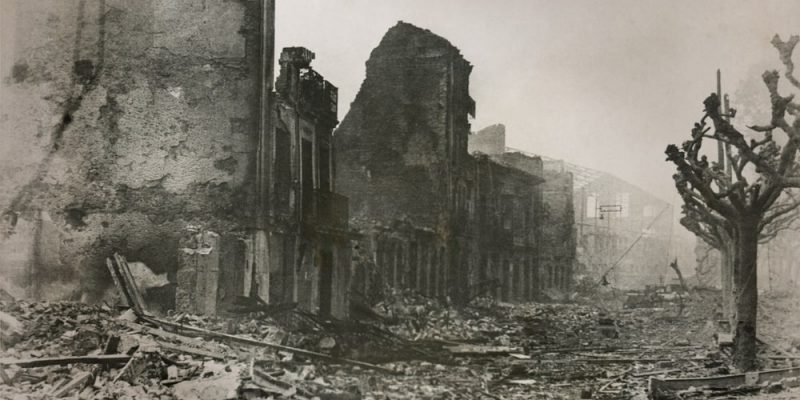We explore Francisco Franco and discuss his military and political career. In addition, his dictatorship, and his death.

Who was Francisco Franco?
Francisco Franco Bahamonde, nicknamed "el Caudillo", was a conservative Spanish military leader and politician who became dictator of Spain for nearly forty years. He was part of the military leadership that staged the coup d'état against the Second Republic in July 1936, which started the Spanish Civil War (1936-1939).
In 1936, he took command of the rebel nationalist forces, drawing military support from Italian fascism and German Nazism. After defeating the Republicans in April 1939, he became head of the Spanish State, ruling Spain until his death in 1975. This period, marked by repression, persecution of dissidents, exile of opponents, and censorship, is known as "Francoism".
- See also: Fidel Castro
Birth of Francisco Franco
Francisco Franco was born in Ferrol, Galicia, on December 4, 1892. He was baptized Francisco Paulino Hermenegildo Teódulo. His father was Nicolás Franco, a naval captain who became general intendant of the Navy. His mother, María del Pilar Bahamonde, also came from a family of military tradition.
Francisco was the second son of the couple. His younger brother, Ramón Franco, was a distinguished aviator known for the feat of the Plus Ultra, the first transatlantic flight from Spain to South America.
It has been suggested that the Franco family home was not exactly a happy one, due to the father's gambling habits and his authoritarian behavior.
Military career of Francisco Franco

Following family footsteps, Franco entered a naval training school at the age of twelve, but failed to gain admission to the Navy and ended up enrolling with a cousin at the Infantry Military Academy in Toledo. He was not an outstanding student, graduating 251st out of 312 in his class.
Subsequently, he was assigned to Spain's African colonial Army at his own request amidst the colonial struggle in the Maghreb known as the Rif War. There, he quickly rose through the ranks, becoming a general in 1926. This made him the youngest general in Europe, which brought him prestige within the army and among the Spanish bourgeoisie.
In 1917, before attaining the rank of general, he had returned to Oviedo, where he met Carmen Polo y Martínez-Valdés, who would become his wife in 1923. During the three years he remained in Spain, Franco was in Asturias during the repression of the strikers in August 1917, and became friends with José Millán-Astray, a military officer and creator of the Spanish Legion, an elite military force within the army.
In 1928, after forging his military career in the war in Africa, Franco was appointed director of the Zaragoza Military Academy. In 1926, his only daughter, Carmen Franco y Polo, was born.
When the Second Republic was proclaimed in Spain in 1931, Franco showed his support to the overthrown monarchy, but remained in the army under Republican authority. In February 1933, the president of the Council of Ministers, Manuel Azaña, assigned him to the Balearic Islands.
Asturias Revolution of 1934

In the general elections held in Spain in late 1933, a right-wing coalition triumphed, which nullified the reforms that had been implemented by the republican-socialist government between 1931 and 1933.
As a result, strikes and clashes between organized workers and law enforcement forces became frequent.
Particularly infamous was the workers' uprising in Asturias, known as the "Asturias revolution", organized by the UGT (socialist) and CNT (anarchist) unions. The acts of violence carried out during the revolt were used as an excuse by the government of Alejandro Lerroux, leader of the Radical Republican Party and president of the Council of Ministers of the Republic, to justify a severe repression. Lerroux's government had the support of the CEDA (Confederación Española de Derechas Autónomas or Spanish Confederation of Autonomous Rights).
The repression, conducted by the Legion and coordinated from Madrid by Franco, resulted in around 1,500 deaths. In 1935, Franco was awarded the Grand Cross of Military Merit and was appointed commander-in-chief of the troops in Morocco. A few months later, he was proclaimed chief of the army's general staff.
Coup d'état of July 1936
Lerroux's government plunged into a crisis caused by corruption scandals in late 1935, forcing him to call an election at the beginning of 1936. The fear that the left would return to power radicalized right-wing groups and strongly polarized Spanish society.
When the Popular Front, a coalition of left-wing parties, won the elections in February 1936, Franco was removed from the head of the general staff and was sent to the Canary Islands. A military conspiracy against the Republican government ensued, led by General Emilio Mola.
Franco joined the conspiracy and, on July 17, 1936, a few days after the assassination of right-wing political leader José Calvo Sotelo, an uprising began in North Africa and spread to the peninsula on July 18.
The call to rebellion was irregularly heeded, particularly in important cities, where the workers' movement as well as socialist and anarchist organizations were stronger. Immediately, Spain became divided into two zones: one loyal to the Republic and the other one loyal to the rebels.
Spanish Civil War

Spain was divided by the coup d'état of 1936, becoming the stage of the Spanish Civil War which for three years pitted the Republicans against the rebels or "Nationalists".
The Republican side comprised a wide range of sectors, including left-wing Republicans, socialists, communists, anarchists, democrats, and peripheral nationalists. The rebel side was composed of military and political nationalists, conservatives, Catholics, traditionalists, monarchists (Carlists and Alfonsinists), and Falangists (of fascist ideology).
The numerical and armament superiority of the rebels was evident, especially so since they counted on the well-trained and well-equipped Army of Africa. Soon, this superiority became even greater due to the military support Franco received from Benito Mussolini (leader of Fascist Italy) and Adolf Hitler (leader of Nazi Germany).
In September 1936, shortly after the war began, Franco was proclaimed "Generalissimo" (chief of all armies) by the other rebel generals, and head of the government during the war. In a ceremony in Burgos on October 1, 1936, he was publicly proclaimed Head of State, a position he held until his death.
The Civil War ended on April 1, 1939 with the victory of Franco's troops and the end of the Second Republic. During the war, 400,000 Spaniards were forced into exile, and it is estimated that between 500,000 and 1,000,000 people were killed in combat or summary executions.
Franco's ties with Nazism

During the Civil War, Franco's troops received the military support of Nazi Germany and fascist Italy, ideological allies of Francoist Spain.
Against this backdrop, the infamous bombing of the Basque town of Guernica, supporter of the Republic, was perpetrated on April 26, 1937 by the Italian Legionary Aviation and the German Condor Legion. The attack resulted in the near-total destruction of the town and the death of over 120 people.
When World War II broke out in September 1939, Franco declared neutrality. His open sympathies for the Axis were counterbalanced by the situation in Spain, with the Civil War recently ended, and by his desire not to antagonize the governments of the United Kingdom and the United States.
The French defeat for a moment seemed to spur Spain's entry into the war on the Axis side: Spain declared itself "non-belligerent" on June 12, 1940, meaning it remained out of the war while acknowledging its pro-Axis stance. Franco met with Hitler in Hendaye (France) on October 23, 1940, and with Mussolini in Bordighera (Italy) on February 12, 1941, but nevertheless, Spain's entry into the war never materialized.
On one hand, Spain wanted the territories of the French colonial empire. On the other, Hitler sought not to openly antagonize Vichy France. Added to this was Hitler's disinterest in Mediterranean affairs and Spain's lack of military readiness after the devastation brought about by the Civil War. These reasons discouraged Spain from entering the war.
However, following the Nazi attack on the Soviet Union in 1941, Franco approved the sending of a volunteer military corps to fight alongside the Germans on the Eastern Front: the so-called Blue Division.
Allied victories made Franco change the state of "non-belligerent" to neutral on October 1, 1943, which implied abandoning his pro-Axis stance. In November that year, he repatriated the Blue Division. Despite Franco's continuous attempts at rapprochement with the Anglo-Saxon Allies, his regime was officially condemned by the United Nations in 1946, with Spain suffering political isolation.
Dictatorship of Francisco Franco
With the Spanish Civil War ended in April 1939, Franco retained the power he had amassed and went on to design the Spanish State to his liking. First, he fiercely repressed political opponents, and passed the Law of Succession to the Headship of the State (1947) re-establishing Spain as a kingdom but leaving power in his hands as head of state for life.
The international community was initially severe with his government, denying Spain’s entry to the UN, and denouncing the ruthlessness of the regime. However, the outbreak of the Cold War benefited Franco, since being a staunch anti-communist ally, in 1948 the United States gave up efforts to oust him from power, and on September 23, 1953 the Spanish-American bilateral agreements were signed, signifying the end of Spain's international isolation and certain economic aid. In 1955, Spain finally joined the United Nations.
Starting in the late 1950s, Spain experienced an economic improvement that became known as the "Spanish miracle". With it also came some social modernization, though the political regime continued to be based on the lack of democratic freedoms.
The Cold War allowed Francoist Spain to join the Western bloc, but the dictatorial nature of his regime determined that this integration would take on a secondary role. Franco's attempts to make Spain enter the European Economic Community (now the European Union), NATO (North Atlantic Treaty Organization), and the Council of Europe were rejected. It was not until after the dictator's death, in 1975, that Spain was able to be fully part of the various international organizations.
Ideology of Francisco Franco

Franco had a nationalist and anti-parliamentary ideology. His dictatorial regime was authoritarian, characterized by some historians as totalitarian, since he nullified democratic freedoms, persecuted political dissidents, encouraged the cult of the leader, and imposed censorship over the media.
Francoism is often compared to German Nazism and Italian fascism, with which it shared traits of its anti-communist ideology and its methods of government and concentration of power. However, the ideology of Francosim also combined militarism and nationalism with traditionalism and the Catholic faith, which explains why Franco defined the uprising against the republic as a "crusade".
Death of Francisco Franco

Franco suffered several heart attacks during 1975, as well as acute peritonitis that complicated other organs. His agony was prolonged, dying in the early hours of November 20, 1975 from septic shock. The president of Spain, Carlos Arias Navarro, announced on television: "Spaniards, Franco has died".
His body lay in state at the Palacio de Oriente in Madrid for fifty hours. It was visited by between 300,000 and 500,000 people. Only then did the transition to democracy begin.
His remains were buried in the Valley of the Fallen. In 2019, they were exhumed and taken to the Mingorrubio Cemetery in El Pardo, Madrid.
References
- Fundación Nacional Francisco Franco (s.f.). Biografía de Francisco Franco Bahamonde. Sitio web de la Fundación Nacional Francisco Franco. https://www.fnff.es/
- Payne, S. G. (2022). Francisco Franco. Encyclopedia Britannica. https://www.britannica.com/
- Preston, P. (2017). Franco. Caudillo de España. Debolsillo.
- Viñas, A. (2015). La otra cara del Caudillo. Mitos y realidades en la biografía de Franco. Crítica.
- Wikipedia (s.f.). Francisco Franco. Wikipedia. https://es.wikipedia.org/
Explore next:
Was this information useful to you?
Yes NoThank you for visiting us :)